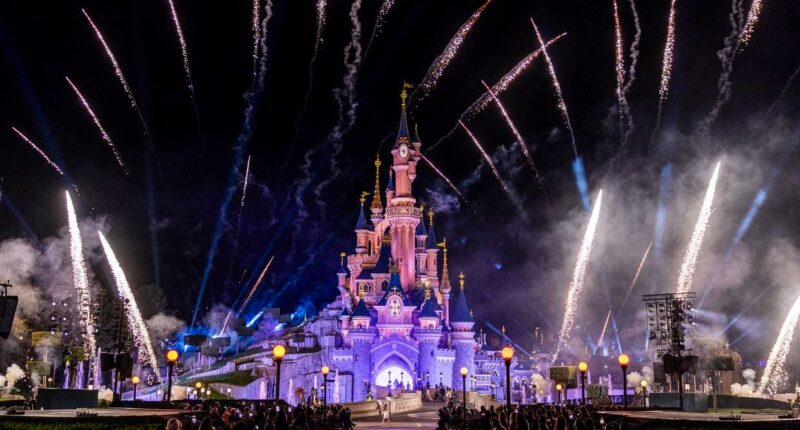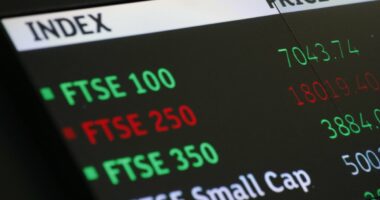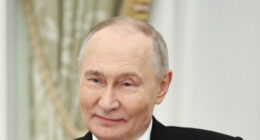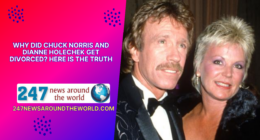Share this @internewscast.com
Disneyland Paris recently announced a significant dip in its net profits, reporting a 45.3% decrease to $98.2 million (€88 million) for the previous year. This downturn is largely attributed to an old agreement that continues to affect its financial results.
Situated just outside of Paris, the resort features an impressive array of attractions, including seven hotels, two convention centers, a 27-hole golf course, and the Disney Village entertainment district, which spans 44,000 square meters. The resort also boasts two theme parks: the enchanting Disneyland Park, which opened in 1992, and the adjacent Walt Disney Studios Park. Since its grand opening, Disneyland Park has experienced a journey filled with ups and downs.
Challenges began early on when then-French President François Mitterrand opted out of the launch party, famously declaring it “not my cup of tea.” Many French citizens were deterred by the park’s high ticket prices, the absence of alcohol in its restaurants, and the predominance of English. The resort was initially 49% owned by Disney, with the remaining shares publicly traded on the Paris Euronext exchange, complicating financial investments.
This public ownership structure hindered Disney from investing as freely as it does in its wholly-owned American parks. Consequently, Disneyland Paris relied heavily on $1.8 billion (€1.7 billion) in bank loans for its development, and Disney provided additional financial support through further loans.
The ownership arrangement had a strategic purpose. To prevent competitors from establishing a presence nearby and to maintain high-quality surroundings, Disney secured a 5,500-acre plot, roughly one-fifth the size of Paris. However, acquiring the land came with conditions set by the French government, leading to the creation of a public-private partnership.
The land, once covered in beet fields and designated for development, saw Disney collaborating with local authorities and EPAMARNE, the public urban management body. This partnership allowed Disney to manage the private interests, while local governments represented the public side. The agreement granted Disney the rights to develop multiple parks on the expansive site.
The land was originally home to beet fields and had long been earmarked for development. Disney committed to develop and transform it in partnership with local governments and EPAMARNE, the local public urban management authority. They represented the public while Disney was the private party in the partnership. It signed an agreement with the government giving it the right to build multiple parks on the sprawling site.
Mickey Mouse and Minnie Mouse stand at the site of the future Disneyland Paris, which opened in 1992. (Photo by Alain Nogues/Sygma/Sygma via Getty Images)
Alain Nogues
The studios park was well into the planning stages long before guests started streaming through the gates of the Disneyland Park. Back then it was due to be called Disney-MGM Studios Europe as it was designed to be an almost-carbon copy of a similarly-named park at Walt Disney World in Orlando, Florida. The Mouse had high hopes for its Parisian counterpart and spent $62.4 million (FF353 million) on planning and design of Disney-MGM Studios Europe in 1993 alone bringing its total investment in it by then to nearly $200 million. The park was originally due to open in 1995 but it was not to be.
A severe recession brought the curtain down on Disney-MGM Studios Europe and dark clouds gathered above the magic kingdom in Paris. So much so that just two years after opening Disneyland Paris had to carry out a $990 million (€907 million) capital increase. Under the terms of this financial restructuring, the resort’s parent company, Euro Disney Associes (EDA), committed to paying a $213 million (€183 million) termination fee to Disney relating to the cost it had incurred on the design and development of the second park between 1990 and 1994.
EDA didn’t have to pay the fee until 2027 at the earliest so the company put it out of its mind and instead focused on weathering the financial storm.
Saudi billionaire Prince Alwaleed joined in on the financial restructuring by buying a 25% stake in Disneyland Paris but it took much more than that to turn the business around.
The clouds began to clear when Disney created more affordable tickets, made French the first language across the resort and introduced alcohol to the restaurants for the first time in a Disneyland park. By 1999 it needed a capital increase of $240 million (€220 million) and this time it was used to revive the studios park.
Only at Disney could lightning strike twice as the studios premièred in 2002 in the midst of the global tourism downturn following 9/11. Three years later Disneyland Paris carried out another financial restructuring including a $276 million (€253 million) capital increase, which was backed by Disney and funded the construction of four new attractions. However, the real villain still needed to be vanquished.
Two decades after Disneyland Paris opened, its bottom line was still being dragged down by finance charges on the bank loans which funded its construction. With a wave of Disney’s magic wand, the debt mountain disappeared in 2012.
Disney took over the debt and refinanced it to significantly reduce the interest rate. It put the resort on course for profitability but that was just the start. In 2014 Disney backed a $1.1 billion (€1 billion) recapitalization of Disneyland Paris and three years later it finally took full control of the company.
The takeover, which this reporter’s colleague forecast in Britain’s Daily Telegraph newspaper, saw Disney pay $2.20 (€2) a share for all of the stock that it didn’t own. The offer was a generous 67% higher than the share price at market close the day before the takeover was announced. It has had a magic touch.
The acquisition was followed by a $1.6 billion (€1.5 billion) recapitalization which was again backed by Disney. Crucially this finally fully de-leveraged the company as documents filed in connection with the transaction referred to the “company’s target debt which is considered to be zero insofar as we have been told that the majority, if not all, of the €1.5 billion capital increase planned after the Offer should be allocated to repayment of debt owed to TWDC [The Walt Disney Company].” There was more good news to come.
In November 2017 my colleague also broke the news in the British newspaper The Express that Disney was planning its biggest show of support yet by investing $2.1 billion in Disneyland Paris. This was finally officially announced in February 2018 by Disney’s chief executive Bob Iger and French president Emmanuel Macron.
They announced that the money would be spent on the biggest expansion in the history of the studios park. According to Disney, interest in behind the scenes tours was declining so it decided to reposition the studios park as a place where guests can immerse themselves in elaborate recreations of the environments from their favorite movies.
Disneyland Paris is due to get a ‘Frozen’ ride similar to the one in Walt Disney World’s Epcot in Florida. (Photo by Matt Stroshane/Disney Parks via Getty Images)
Getty Images
Three new lands for the park were announced with the first being the superhero-themed Avengers Campus, which opened in 2022. This will be followed by an area based on the hit animated film Frozen which will open next year when the studios park will be renamed Disney Adventure World. Its third land is due to debut after that and will be themed to classic Disney cartoon The Lion King.
That’s not all. In 2018 my colleague revealed that Disney Village would be transformed by both a major renovation and expansion and this was finally officially announced four years later. There is good reason why Disney has thrown its weight behind the resort.
Disney’s investment has transformed it from an ugly duckling into the prince charming of the media giant’s portfolio of international parks. There is no doubt about that.
Talking to analysts in August Disney’s chief financial officer Hugh Johnston said that its outpost in Paris “is performing strongly” and added that he expects it “to do very well”. He didn’t provide any specific numbers as Disney doesn’t disclose the costs and revenues of individual parks in its commentary or filings in the U.S.
Likewise, Disneyland Paris declined to comment on its financial performance. There is no need for it to do so as EDA files financial statements which shine a spotlight on everything from its earnings to the amount invested in its two parks.
As this reporter revealed in The Times of London, EDA’s latest financial statements show that its net profit plummeted 45.3% to $98.2 million in the year to 30 September 2024 despite its revenue rising 7.4% to a record $3.5 billion (€3.1 billion) following the re-opening of its palatial pink flagship hotel. The Disneyland Hotel re-opened in January last year with prices hitting $12,000 per night for the Frozen-inspired royal suite.
It gave a sparkle to EDA’s revenue but the termination fee for Disney-MGM Studios Europe came back on the scene to stop the boost to the company’s revenue from fully filtering down to the bottom line.
Ahead of the $213 million coming due in 2027 EDA and Disney decided to terminate the commitment for the money to be paid. In return, EDA booked a $53.6 million (€48 million) charge in its 2024 financial statements and although this was a non-cash transaction, which was settled through a debt-to-equity conversion, it drove down the net profit.
The charge was slightly offset by income from the sale of land subject to a construction lease at the nearby Les Prés de la Fontaine site. It led to EDA being charged a net $44.7 million (€40 million) which represented 55% of the $81.5 million (€73 million) decrease in its net profits last year.
It still managed to work its magic as the charge also reduced EDA’s tax bill which came to just $1.1 million (€1 million).
Even though Disneyland Paris has become a dream ticket for its owner, maintaining that status might not be a walk in the park. In 2031 Disney’s arch-rival Universal Studios is due to open a park in the United Kingdom just a few hours by train from Paris. Disneyland Paris has some tricks up its sleeve to take it on but there is no guarantee they will work.
The launch of a ‘Frozen’ lake show at Disneyland Paris in January 2020 was almost entirely obscured by freezing fog.
MSM
The highlight of the upcoming Frozen land is a log flume which is one of the oldest ride systems in the theme park industry. The ride itself is a copy of one which opened at Disney World in 2016 and has since been copied at Hong Kong Disneyland. Its Frozen land opened two years ago and also includes another ride which Paris lacks. In summary, the Frozen land isn’t unique or groundbreaking.
Nevertheless, it sits next to a man-made lake which will be home to a new night time show next year. It is a bold gamble given that Paris is bitterly cold at night for many months of the year. It is highly likely that wind will whip over the large lake picking up water droplets and dropping them on audiences around the perimeter.
Visibility could also be an issue as a Frozen-themed show on a lake at the Disneyland Paris hotel complex could barely be seen due to freezing fog when it debuted in January 2020. Furthermore, Disney’s recent track record with night time shows is far from picture perfect.
In April 2023 scathing reviews led to the Disney Enchantment fireworks display at Disney World’s Magic Kingdom park being dropped after just 18 months. In the same year, Disney’s neighboring Epcot park dropped its new son et lumière show Harmonious after excoriating feedback from fans.
Then, last year, Disneyland in California was beset by criticism when it resumed its flagship nighttime show Fantasmic after a one-year hiatus. Fantasmic was put on hold following a fire inside the 45-feet animatronic dragon at the heart of the show but instead of repairing it, Disney replaced it with an actor. With a major new competitor on the horizon Disneyland Paris may have to do better than that if it wants a happy ending.
Additional reporting by Christian Sylt








